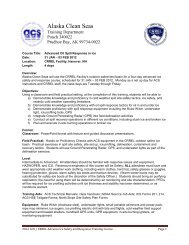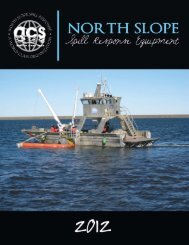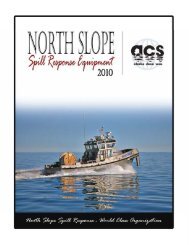(ACS) Technical Manual - Alaska Clean Seas
(ACS) Technical Manual - Alaska Clean Seas
(ACS) Technical Manual - Alaska Clean Seas
- No tags were found...
Create successful ePaper yourself
Turn your PDF publications into a flip-book with our unique Google optimized e-Paper software.
TACTIC S-1 Site Entry Procedures (Page 1 of 4) Site Entry Procedures (Page 2 of 4) TACTIC S-1SAFETY IS THE FIRST PRIORITYIN THE RESPONSE TO ANY TYPE OF SPILLRemember, it’s not worth risking injury to anyone to clean up a spill. Safety protocols and procedures must be followedfor any spill. Proper hazard identification, hazard assessment, selection of appropriate personal protectiveequipment (PPE), personnel decontamination, and determination of appropriate safety and health practicestake priority over all other spill response activities.LIMITS TO ENTRY• No entry is authorized if the percentage of LEL exceeds 10% on a calibrated directreadingexplosive gas meter.• No entry is authorized if the oxygen percentage exceeds 23.5%.• In all cases, physical hazards of entry must be considered along with health hazardsKey safety issues to consider in mobilizing a response effort are:• Fire and explosion risk• Chemical exposure potential• Temperature extremes• Safety of on-water or on-ice operations• Other physical hazardsNot all hazards at an oil spill site are immediately apparent. A number of factors can be dangerous in the presenceof an oil spill. Beware of the following:• Potential ignition (“hot”) sources for fire/explosion• Smoking in the area• Static electricity• Escaping gas• Unauthorized visitors (e.g., media)• Undetected mechanical failures• Spontaneous combustion• Physical hazards (e.g., structural damage to pipeline or facilities)• Chemical hazards (e.g., components in the oil, either naturally occurring or added, that are toxic to humans)Effective spill response depends upon correct identification of the materials released. The Safety Officer willuse his/her professional judgment to determine the following:• Type of product or material released• Physical state of material released (liquid, spray, solid, emulsified, mist, vapor, gas)• Air concentration of material as compared to: 1) flammability range, 2) whether immediately dangerous to lifeor health (IDLH), 3) permissible exposure limit (PEL)*• Hazards associated with material (e.g., flammability, toxicity, reactivity, corrosivity, health hazards)• Weather conditions (e.g., prevailing winds, ambient temperatures, wind chill, relative humidity)• Threat to human health and environmentally sensitive areasIn cases of release of an unknown material, the Safety Officer will assist with identification:• Use available information such as labels, transport placards, NFPA, DOT Emergency Response Handbook,or bill of lading.• Take sample, using accepted EPA protocol.• If identified, consult material safety data sheet (MSDS) or operator’s safety department.• If no MSDS available, call CHEMTREC (1-800-424-9300 or 1-703-527-3887).PRE-ENTRY SAFETYThe decision as to whether of not any given entry shall be attempted is ultimately the responsibility of the On SceneCommander with advice and guidance from:• The Site Safety Officer (safety professional or experienced responder)• The Emergency Response Leader• The Environmental Team LeaderSteps to follow during the pre-entry phase to provide maximum safety to workers, the environment, and facilities:• Before any site activity, all known facts about the incident are discussed in a pre-entry briefing.• Known site hazards are identified.• A Site Safety Officer makes a preliminary evaluation of a site’s characteristics (hazards) before site entry.The Site Safety Officer performing the initial assessment will:• Determine if people are injured or trapped. If so, contact help as soon as possible.• Delineate affected area (Hot and Warm Zones).• Designate site as “Dangerous - No Smoking.”• Stay upwind from spill.• Restrict access to spill area to those involved in initial containment.• Note any geographic hazards (cliffs, fast-moving water, ditches, etc.).• Consider the need for the following: protective gear, decontamination, site control, and safety equipment.• Gather any and all pertinent data (begin evaluation).SITE ENTRYImmediately after the initial site entry, a more detailed evaluation of the site’s specific characteristics is completedin order to further identify existing hazards and aid in the selection of appropriate PPE.Below are three levels of protection for entry into varying conditions listed in descending order of protection. It is requiredto consult with a “competent person” for job specific PPE requirements. (Note: The recommended levels belowreflect a 12-hour shift. All employees must have had the necessary training pertaining to their tasks prior to enteringany site. In addition, these guidelines are for crude oil and petroleum spills; other criteria apply to hazmat spills).1. Entry by one or more workers with SCBA and a single backup observer also equipped with SCBA is allowedunder the following conditions:• Oxygen atmospheric concentration is less than 23.5%.• LEL percentage is less than 10% as measured by a calibrated direct-reading hand-held instrument.2. Entry with full-face air purifying respirator and organic vapor cartridges is allowed by any number of workerswithout backup observers under all of the following conditions:• Oxygen atmospheric concentration is between 19.5% and 23.5%.• LEL percentage is less than 3%.• Total hydrocarbon concentration is less than 500 ppm.• H 2S air concentration is less than 10 ppm.• Benzene air concentration is less than 10 ppm.• Normal natural or mechanical ventilation is available.• No visible mist or fog of oil present.*The PEL is 5 mg/m 3 for particulate oil in air (e.g., from a high-pressure release of oil), and the PEL is 0.6 ppm for benzene in oil.In addition, oil may contain methanol and xylene from injection at the wellbore.<strong>ACS</strong> Tech. <strong>Manual</strong> Vol. 1, 03/12NOTE: All values given on these pages are for planning purposes only. NOTE: All values given on these pages are for planning purposes only. <strong>ACS</strong> Tech. <strong>Manual</strong> Vol. 1, 03/12






